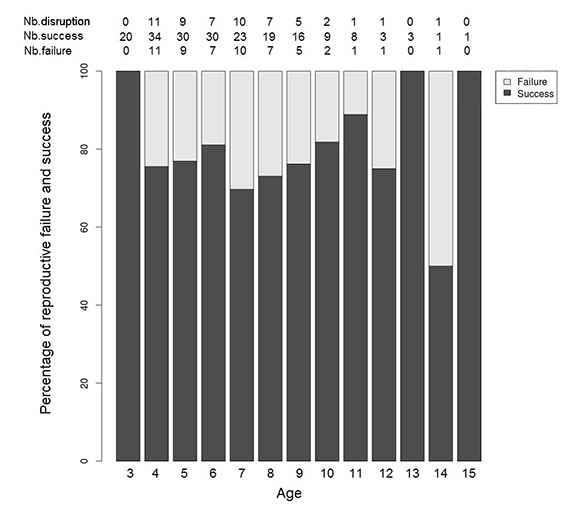
Ecological Archives E096-005-A2
Vérane Berger, Jean-Franҫois Lemaítre, Jean-Michel Gaillard, and Aurélie Cohas. 2015. How do animals optimize the size–number trade-off when aging? Insights from reproductive senescence patterns in marmots. Ecology 96:46–53. http://dx.doi.org/10.1890/14-0774.1
Appendix B. Age variation in reproductive probability.
In birds and mammals, age-specific variation in the probability of reproduction has been commonly reported since Emlen's (1970) pioneering work (e.g., Cam et al. 2002, McElligot et al. 2002, Beauplet et al. 2006, Berman et al. 2008). We add to that record with our data on whether dominant female Alpine marmots successfully raised offspring until weaning or not. For each failed reproduction, we also recorded whether a social disruption occurred or not. Firstly, we recorded whether there was a change in the dominant male. A change in the identity of the dominant male involves (i) females failing to be fertilized if the change occurs during females' fertile period; (ii) females reabsorbing the embryos (Bruce effect, Bruce 1959) if the change of the dominant male occurs during pregnancy; and (iii) females losing all their litter by infanticide if the change of the dominant male occurs after parturition. Secondly, we recorded whether an individual from outside or from inside a given family group tried but failed to take over the territory.
In our studied population of Alpine marmots (Marmota marmota), 54 failures to raise offspring until weaning occurred (33 females) over 251 reproductive events (by 65 females) (Fig. A1) and all were systematically associated with a disruption of the social context.
Fig. B1. Percentage of reproductive failures of females of different age in Alpine marmots at La Grande Sassière (French Alps). Nb.disruption corresponds to the number of social disruptions. Nb.success corresponds to the number of females of a given age that succeeded in weaning offspring. Nb.failure corresponds to the number of females of a given age that failed to wean offspring.
Literature cited
Beauplet, G., C. Barbraud, W. Dabin, C. Küssener, and C. Guinet. 2006. Age-specific survival and reproductive performances in fur seals: evidence of senescence and individual quality. Oikos 112 430–441.
Berman, M., J-.M. Gaillard, and H. Weimerskirch. 2009. Contrasted patterns of age-specific reproduction in long-lived seabirds. Proceedings of the Royal Society of London. Series B, Biological Sciences 276:375–382.
Bruce, H. M. 1959. An exteroceptive block to pregnancy in the mouse. Nature 184:105.
Cam, E., B. Cadiou, J. E. Hines, and J-.Y. Monnat. 2002. Influence of behavioural tactics on recruitment and reproductive trajectory in the kittiwake. Journal of Applied Statistics 29:63–185.
Emlen, J. M. 1970. Age Specificity and Ecological Theory. Ecology 51:588–601.
McElligot, A. G., R. Altweggl, and T. J. Hayde. 2002. Age-specific survival and reproductive probabilities: evidence for senescence in male fallow deer (Dama dama). Proceedings of the Royal Society of London. Series B, Biological Sciences 269:1129–113.